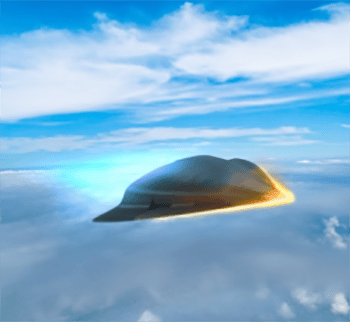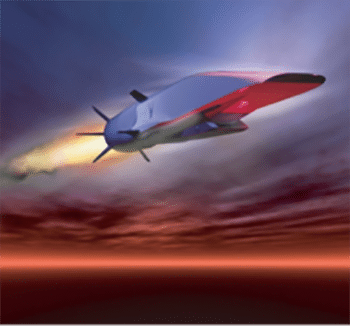MIKE HALEY
What are Hypersonics?
Hypersonic vehicles travel within a flight regime from Mach 5 to Mach 10 while high Hypersonic vehicles travel Mach 10 to Mach 25. Mach 1 is 767 mile per hour (mph) so at the high end, a Mach 25 vehicle is cruising at 19,175 mph! Put in perspective, a commercial airliner travels at approximately 500 mph so when your grandchildren boards that Mach 5 hypersonic airliner they will be traveling at 3,835 MPH. That means a trip from Los Angeles to New York City will take approximately 44 minutes. The movies will likely be shorter.
How do they get that fast?
There are two design approaches to achieving > Mach 5 speeds. One approach is to launch a hypersonic glide body using a booster motor while the second approach is the use of a SCRAMJET or supersonic-combustion ramjet. What sets these apart from ballistic missiles is just that. Ballistic missiles achieve Mach 25 in the midcourse phase but fly a predictable flight path versus a hypersonic vehicle that is highly maneuverable.
How do you defend against a hypersonic vehicle?
To quote an old western movie, it’s “the quick or the dead” solution. The OODA Loop (Observe-Orient-Decide-Act) is measured in minutes so the entire chain must be rapid and may ultimately require Artificial Intelligence for success. Presently, the U.S. is developing a layered ISR (Intelligence, Surveillance, Reconnaissance) satellite-based network in addition to integrating our existing land-based phased array radar networks for the Observe phase. The ISR system will also provide flight path information to solve the Orient question. The next two steps, Decide-Act, will require pre-set Rules of Engagement (ROE) to eliminate confusion that will result in delay. The Missile Defense System has an existing process that will likely be leveraged.
What do they look like?
Back to the two types, a Glide Body design and a SCRAMJET design. Scroll to bottom of page for visuals.

Where is the U.S. right now?
Developing Hypersonic vehicles and related defense systems are a national priority. $14B is budgeted in the current FY20 FYDP (Future Years Defense Program) and significant increases are expected in the FY22 FYDP. Over 40 flight tests across the services are planned for FY20—24. The U.S. Air Force Air-Launched Rapid Response (ARRW), Lockheed Martin as prime, will be first to be fielded in FY22, designated the AGM-183. Conventional Prompt Strike (CPS) is a joint Army/Navy initiative utilizing a common glide body. The Army will conduct live fire tests from a M870A4Transporter-Erector-Launcher (TEL) in 2022 while the Navy will conduct cold launch from a SSGN in 2025 followed by Virginia class SSN IOC in 2028.
What are some of the technical challenges?
The flight regime is harsh. Lockheed Martin identifies four primary challenges:
HEAT
At hypersonic speeds, friction and air resistance create an incredible amount of heat, which needs to be managed through tough but lightweight heat shields and thermal protection systems. Instruments, like sensors and electronics, must also be equipped and protected to stand up to these extreme conditions.
ADVANCED MATERIALS
Managing extreme heat and speed requires inventing and deploying new solutions, advanced materials and composites that can withstand extreme environments.
MANEUVERABILITY
Hypersonic systems are designed to operate in contested environments and must be capable of overcoming a wide range of defenses. At hypersonic speeds, maneuverability is a big challenge that demands extensive calculation and development.
COMMUNICATION
Basic operations, like communications, become significant during hypersonic flight. Personnel need continuous connectivity to operators and decision-makers through global communications and sensor systems that can operate within these high-speed environments.
What role is PacSci EMC playing?
Like many complex systems, the use of pyrotechnic devices provides the most work for the lightest weight. PacSci EMC has a variety of applicable products. These span our extensive CAD/PAD product lines such as propulsive bolts to cutters used
in a number of vehicle subsystems. From our linear explosive product line, Explosive Transfer Lines (ETL) and Linear Shaped Charge (LSC) are effective solutions. Our Integrated Electronic/ Pyrotechnic (IEP) capability provides Arm-Fire Devices (AFDs) and Electronic Safe-Arm Devices (ESADs).
In addition, these vehicles are demonstrated at test ranges across the country. If the vehicle does not perform as intended, the Range Safety Officer can destroy the vehicle in flight. PacSci EMC has designed Flight Termination Systems (FTS) that when commanded will cause the destruction of the vehicle. The FTS is governed by requirements of RCC319 and the FTS is qualified to those requirements.

